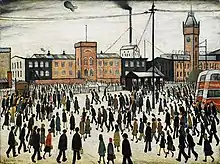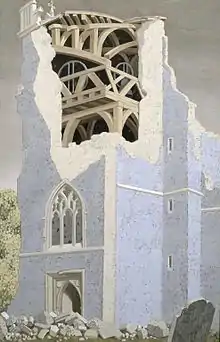War Artists' Advisory Committee
The War Artists Advisory Committee (WAAC), was a British government agency established within the Ministry of Information at the outbreak of the Second World War in 1939 and headed by Sir Kenneth Clark. Its aim was to compile a comprehensive artistic record of Britain throughout the war. This was achieved both by appointing official war artists, on full-time or temporary contracts and by acquiring artworks from other artists. When the committee was dissolved in December 1945 its collection consisted of 5,570 works of art produced by over four hundred artists.[1] This collection was then distributed to museums and institutions in Britain and around the world, with over half of the collection, some 3,000 works, going to the Imperial War Museum.
Aims and objectives

The stated aim of the WAAC, and the War Artists Advisory Scheme, which it ran, was:[2]
to draw up a list of artists qualified to record the war at home and abroad. In co-operation with the Services Departments, and other Government Departments...to advise on the selection of artists on this list for war purposes and on the arrangements for their employment
Clark, then Director of the National Gallery, was the driving force behind the establishment of the Committee. The advent of World War II saw many artists cease working and lose their incomes as commercial galleries closed, private commissions ceased and the art schools reduced their teaching or closed altogether. This led Clarke to fear that there would not be a contemporary artistic, visual record of the war. His lobbying for Government support for artists during the conflict directly led to the formation of WAAC. Whilst the primary purpose of the Committee was propaganda and organising art exhibitions in Britain and America to raise morale and promote Britain's image abroad, Clarke later admitted that he also hoped that the scheme might also prevent artists from being killed on front line service.[3]
Membership
The WAAC met at the National Gallery once a month, with members drawn from government departments, the forces and London art schools.[4] The original members of the Committee were
- Sir Kenneth Clark, Chair of WAAC
- E.M.O'R. Dickey, Committee Secretary until 1942 then a Committee member
- E.C. Gregory, Committee Secretary from 1942
- Muirhead Bone, artist member and trustee of the Imperial War Museum
- Percy Jowett, artist member and Principal of the Royal College of Art
- Walter Russell, artist member and Keeper of the Royal Academy Schools
- Colin Coote, War Office representative
- R.M.Y. Gleadowe, Admiralty representative
- W.P. Hildred, Air Ministry representative, until 1940
- T.B. Braund, Ministry of Home Security representative, until 1940
- Randolph Schwabe, member from 1941 and Slade Professor of Fine Art UCL
Later in the war representatives from the ministries of Supply, Production and War Transport joined the Committee. Although some of the original members were moved to other duties as the war developed, Clark, Bone, Dickey and Russell remained active members throughout the conflict.[5]
Operations
.jpg.webp)
The Committee operated by employing artists on full-time contracts, offering short-term commissions to artists on individual subjects and by purchasing finished works offered to it. In total WAAC acquired artworks from some four hundred artists.[5] It also issued permits allowing artists access to otherwise restricted areas and rationed materials. Wartime rationing restricted good quality paper for printmaking and materials for sculpture so such works were under-represented in the WAAC collection. In June 1941, WAAC established a scheme to obtain artworks by artists from Britain's overseas colonies.[6] Although four artists were sent to record the activities of the British Expeditionary Force in France, at the start of the war the majority of WAAC commissions were for subjects on the British home front,[7] but as the conflict progressed twenty-six men were given overseas commissions. Among these were Edward Ardizzone, Henry Carr, and Edward Bawden who each went to the Middle East, Leslie Cole was sent to Malta, France and South-East Asia, Vivian Pitchforth went to Burma, and Anthony Gross went to the Middle East and Burma before joining the Normandy landings. Two women, Mary Kessell and Laura Knight, were also, towards the end of the war, given overseas commissions.[8][9] Other artists serving overseas but working without a WAAC commission or contract, submitted work which was then purchased by the Committee. These included Doris Zinkeisen and Stella Schmolle serving with the Red Cross and the Auxiliary Territorial Service respectively.[8] Three artists, Thomas Hennell, Eric Ravilious and Albert Richards, were killed during the Second World War whilst working on WAAC commissions.[10][9]
Publications
The Committee produced two sets of four paperback booklets during the war, both called War Pictures by British Artists. Each booklet consisted of an introductory essay and fifty black-and-white reproductions. The first set of four, entitled Army, Blitz, R.A.F and War at Sea, sold some 24,000 copies and led to a second set, Air Raids, Production, Soldiers and Women, being published in 1943.[11] Attempts by the Committee to produce more extensive and higher quality publications fell foul of war-time printing restrictions and rationing.[5]
Exhibition programme

Overseas exhibitions
- Britain at War was the Committee's major overseas exhibition with oils and watercolours from over thirty artists. It opened at the Museum of Modern Art, New York, in May 1941, with some 3,000 people attending on the opening day.[11] The selection of works was aimed at undermining American neutrality. The exhibition went on to Baltimore before fourteen images, with Canadian themes, were added for showings in Ottawa, Toronto and Montreal. The exhibition was then split in two for display in Pittsburgh and London, Ontario before the entire catalogue was exhibited in San Francisco in 1942. Britain at War then toured Central and South America in place of 111 WAAC paintings that had been lost when the ship taking them to Rio de Janeiro was sunk.[5]
- India in Action, which toured Australia, New Zealand and the United States in 1944 and 1945, consisted of fifty-one drawings by Anthony Gross, made in 1941-43 of Indian forces in the Far East.
- An exhibition of over one hundred pictures was displayed in South Africa from 1944 to 1947.[5]
UK exhibitions
.jpg.webp)
WAAC organised exhibitions around the United Kingdom on a large scale and to a regular schedule.
- The Museums Association organised an exhibition of WAAC items which visited 65 venues, mostly regional museums and well established galleries.
- Four exhibitions of WAAC war art were toured by the British Institute of Adult Education to eighty smaller, more informal locations.
- With the National Gallery's own collection evacuated from London, WAAC used space in the Trafalgar Square building to display works from its growing collection. From July 1940 onwards, new works were added at regular intervals and the exhibition remained open throughout the war, bar a short period in October 1940 due to damage from air raids.
- The War at Sea;- shown at the National Gallery in September 1944 consisted of 52 paintings by Norman Wilkinson. Wilkinson was a World War I navy veteran and during World War II he travelled extensively on Royal Navy ships and was aboard HMS Jervis on D-Day. WAAC bought one painting from Wilkinson and he donated the other fifty-one paintings to the Committee. Throughout 1945 and 1946 the exhibition was shown in Australia and New Zealand.
- 400 works from the collection were exhibited at the Glasgow Art Gallery in the spring of 1945.
- A final exhibition of the WAAC collection was held at Burlington House between 13 October and 25 November 1945. The exhibition consisted of 1028 drawings, paintings and prints plus twenty-one sculptures, but attracted less than 20,000 paying visitors in total.[5][11]
Legacy
_(Art.IWM_ART_LD_4039).jpg.webp)
The WAAC was dissolved in December 1945 and its operations transferred to a joint committee of the Imperial War Museum and the Ministry of Information. When the Ministry of Information itself was disbanded in March 1946, WAAC's remaining responsibilities passed entirely to the Imperial War Museum. Whilst some artists were still finishing WAAC contracts and money was available to purchase works to fill any gaps in the collection, the major responsibility at this point was deciding how to disperse the collection. The collection now consisted of 5,570 works of art. By the end of 1947 these works had been distributed to some sixty museums, galleries, government departments and other bodies in Britain and around the world. Care was taken to ensure that works by the finest artists was distributed as widely as possible. For example, the twenty-seven drawings by Henry Moore of coal mines and the London Underground shelters went to eleven different museums and galleries while the hundred or so works by Graham Sutherland were placed with thirty different institutions. Over half the collection, some 3,000 items, was acquired by the Imperial War Museum, while the Tate took seventy-six pieces and the British Council some twenty-five works.[5]
WAAC artists
Thirty-six men and one woman were given full-time employment by the Committee, a hundred other artists were given short-term contracts, and works by a further 264 artists, both professional and amateur, were purchased. Three artists donated works to the collection.[5]
Artists on full-time salaried contracts
Artists given short-term WAAC contracts
Artists whose work was acquired by WAAC
References
- National Portrait Gallery. "World War II: Official War Artists". National Portrait Gallery. Retrieved 29 February 2016.
- Imperial War Museum. "War Artists Advisory Committee". Imperial War Museum. Retrieved 3 September 2013.
- Ronan Thomas (8 December 2010). "Blitz by Brushstroke; Westminster's War Artists". 'West End at War'. Retrieved 13 September 2013.
- Roger Tolson (Imperial War Museum). "A common cause: Britain's War Artist Scheme" (PDF). Canadian War Museum. Retrieved 10 September 2013.
- Brain Foss (2007). War paint: Art, War, State and Identity in Britain, 1939-1945. Yale University Press. ISBN 978-0-300-10890-3.
- Imperial War Museum. "Scheme for War Pictures by Native-born Colonial artists". Imperial War Museum. Retrieved 3 April 2017.
- Caroline Lewis. "War Artists - World War Two on Canvas and Paper Part One: The Home Front". culture24.org.uk. Retrieved 9 September 2013.
- Kathleen Palmer (2011). Women War Artists. Tate Publishing/Imperial War Museum. ISBN 978-1-85437-989-4.
- Juliet Gardiner (12 March 2006). "Toils of War". The Telegraph. Retrieved 2 April 2017.
- Ministry of Defence. "Ministry of Defence Art Collection". The Ministry of Defence. Retrieved 9 September 2013.
- Sacha Llewellyn & Paul Liss (2016). WWII War Pictures by British Artists. Liss Llewellyn Fine Art. ISBN 978-0-9930884-2-1.